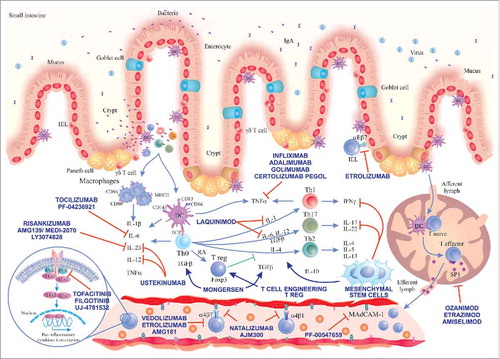Figures & data
Table 1. Novel drugs, therapeutic targets and current status in clinical studies.
Figure 1. Immunological pathways targeted by the main novel therapies for IBD. A loss of intestinal barrier integrity takes place in IBD, leading to translocation of bacteria that triggers an exaggerated immune response with secondary activation of Th cell responses (Th1, Th2, Th17). We show the main drugs inhibiting IL-6 pathway, IL-12/23 axis, Jak inhibitors, laquinimod and stimulators of TGF-β1 pathway (mongersen). Drugs inhibiting TNF-α already approved for use in IBD and cell therapies using MSCs and Tregs and their main immune-modulation functions are depicted in the centre. Substances targeting different adhesion molecules are described in the blood vessel and in the gut epithelium (etrolizumab). On the bottom right, we show the mechanism of action of drugs reducing the circulating lymphocytes by sequestering them in secondary lymphoid organs (sphingosine-1-phosphate receptor modulators). Main abbreviations: IEL, intraepithelial lymphocyte; DC, dendritic cell; JAK, Janus kinase; STAT, signal transducer and activator of transcription; IL, interleukin; Th, T helper lymphocyte; TGF-β, transforming growth factor-beta; RA, retinoic acid; IFNγ, interferon gamma; S1P, sphingosine-1-phosphate.

